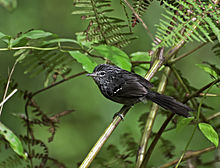The dusky-tailed antbird (Drymophila malura) is an insectivorous bird in the antbird family Thamnophilidae. It is found in southeast Brazil, southern Paraguay, and northeast Argentina (Misiones Province). Its natural habitat is subtropical or tropical moist lowland forest.
| Dusky-tailed antbird | |
|---|---|

| |
| Male, Reserva Guainumbi, São Luis do Paraitinga, São Paulo, Brazil | |
| Scientific classification | |
| Domain: | Eukaryota |
| Kingdom: | Animalia |
| Phylum: | Chordata |
| Class: | Aves |
| Order: | Passeriformes |
| Family: | Thamnophilidae |
| Genus: | Drymophila |
| Species: | D. malura
|
| Binomial name | |
| Drymophila malura (Temminck, 1825)
| |

| |
The dusky-tailed antbird was described by the Dutch zoologist Coenraad Jacob Temminck in 1825 and given the binomial name Myiothera malura.[2][3] It is now placed in the genus Drymophila which was introduced by the English naturalist William Swainson in 1824.[4] The specific epithet malura is from the Ancient Greek malos "soft" or "weak".[5]
References edit
- ^ BirdLife International (2016). "Drymophila malura". IUCN Red List of Threatened Species. 2016: e.T22701637A93841110. doi:10.2305/IUCN.UK.2016-3.RLTS.T22701637A93841110.en. Retrieved 11 November 2021.
- ^ Temminck, Coenraad Jacob (1838) [1825]. Nouveau recueil de planches coloriées d'oiseaux, pour servir de suite et de complément aux planches enluminées de Buffon (in French). Vol. 2. Paris: F.G. Levrault. Plate 353, Figs. 1 & 2. The 5 volumes were originally issued in 102 parts, 1820-1839
- ^ Peters, James Lee, ed. (1951). Check-list of Birds of the World. Vol. 7. Cambridge, Massachusetts: Museum of Comparative Zoology. p. 210.
- ^ Swainson, William John (1824). "An inquiry into the natural affinities of the Laniadae, or shrikes; preceded by some observations on the present state of ornithology in this country". Zoological Journal. 1: 289–307 [302].
- ^ Jobling, J.A. (2018). del Hoyo, J.; Elliott, A.; Sargatal, J.; Christie, D.A.; de Juana, E. (eds.). "Key to Scientific Names in Ornithology". Handbook of the Birds of the World Alive. Lynx Edicions. Retrieved 21 March 2018.
